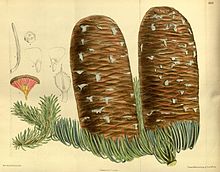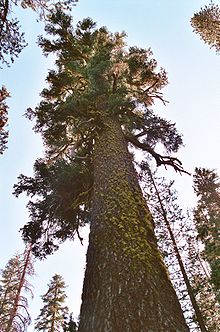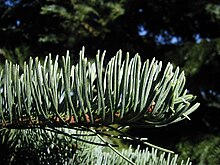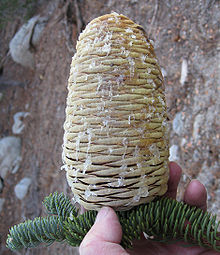Magnificent fir
| Magnificent fir | ||||||||||||
|---|---|---|---|---|---|---|---|---|---|---|---|---|

Magnificent fir ( Abies magnifica ) |
||||||||||||
| Systematics | ||||||||||||
|
||||||||||||
| Scientific name | ||||||||||||
| Abies magnifica | ||||||||||||
| A.Murray up |
The superb fir ( Abies magnifica ) is a plant from the genus of fir ( Abies ) in the family of Pinaceae (Pinaceae).
description
Habitus
In favorable locations, magnificent firs grow into impressive, evergreen trees with heights of 65 to 70 meters. There are breast height diameter reached 2.4 to 3 meters. Specimens of this size and age have a knot-free trunk and a crown with short branches and a rounded tip. While the upper branches are directed upwards, the lower ones hang down a little. Young trees grow very symmetrically with horizontally protruding branches. Young shoots have short, shaggy hairs and are somewhat furrowed. Due to its exposure , the magnificent fir is struck by lightning relatively often.
Buds and needles
The magnificent fir forms approximately 0.8 centimeters long, egg-shaped buds. The buds have a maroon color and are resinous at the apex . The very dense needles have an almost square cross-section and are 2 to 3.7 centimeters long. There are 6 to 8 rows of stomata on all four sides . On branches exposed to light, the needles are blue-green in color and curved upwards. Needles on cone-bearing branches are thicker and have a conspicuous central rib. The needles stay on the tree for up to 10 years.
bark

In youth, the bark is still thin and gray until it takes on the typical red color in old age. The bark is up to 12 centimeters thick at the base of the trunk.
root
The shape of the roots depends heavily on the soil. The seedlings form a taproot that not all old trees maintain. Both root adhesions and mycorrhizal symbioses occur. Details are missing.
Wood
The relatively light, soft and coarse-grained wood is easy to work with. The heartwood hardly stands out in color from the sapwood. The annual rings are clearly visible. Most of the resin channels are missing.
| Physical parameters | value | unit |
|---|---|---|
| Density ( ) | 0.34 | g / cm³ |
| Compressive strength , perpendicular to the fiber | 4.5 | MPa |
| Flexural strength | 74.4 | MPa |
Flowers, cones and seeds
The magnificent fir becomes sexually mature at around 35 to 40 years of age and flowers from May to June. They are single sexed ( monoecious ). Male cones can be found on annual branches and are deep purple in color; they are relatively small at 1.6 centimeters and only grow on the underside of branches. The female cones are all located in the area of the crown tip on branch tops with a greenish, reddish color to the top of the scales. The seeds ripen in August that same year. When the seeds are ripe, the cones are brown, 15 to 23 inches long and up to 8.5 inches wide. No other type of fir has such cone dimensions. The cone scales are about 30 millimeters long and 27 millimeters wide. The seeds are released in late September to mid-October. The relatively large, dark brown seeds are spread by the wind ( anemochory ). The seed wings are about the same length as the seed body. The thousand grain weight is around 70 grams, with var. Shastensis a little lower.
ecology
The magnificent fir populates cool-damp to cold-damp mountain areas. The temperature fluctuates in their habitat from +29 ° C to −29 ° C. The precipitation is 750 to 1,500 millimeters. It is sensitive to dryness and moisture. Fresh, deep soils are named as the optimal subsurface. It also grows on steep slopes. The magnificent fir is not a pure light or shade tree. It is a pioneer species after forest fires.
distribution
The magnificent fir has its natural range, especially on the west side of the high Sierra Nevada in the US state of California . It also grows in the Siskiyou Mountains in southern Oregon and on the Coast Mountains in northern California. There is also a small strip of the area in the far west of Nevada . The magnificent fir often grows in pure stands at snow-rich altitudes of 1400 meters to 2740 meters. In its area of distribution it is considered the climax tree species . There were no planned extensions in Central Europe. This species is also rarely found in collections.
Pests
Felling and logging damage are of particular economic importance , because they are often the site of infection for wood destroyers and root parasites . Otherwise it is quite insensitive to abiotic damage.
The infestation of dwarf mistletoe and the causative agent of pine cancer is widespread . Cone pests are of concern among the insect pests, but the pine bark beetle ( Scolytus ventralis ), a bark beetle, causes far greater damage . Sometimes ground squirrels not only reduce rejuvenation , but can also significantly damage the root system of older trees.
use
Since the wood is not very durable, it is only used after treatment with wood preservatives . The wood of the splendid fir does not play a significant role on the market, as it is never available in large quantities because of the often difficult-to-access habitats. It is mainly used as fuel and as plywood . It used to be used as pit wood.
The magnificent fir is a very popular Christmas tree in California . The bark of old trunks is often burned in the campfire because it behaves like glowing coal.
Systematics
Abies magnifica is divided into three varieties :
- Abies magnifica var. Critchfieldii Lanner : It occurs in central California.
- Abies magnifica var. Magnifica (Syn .: Abies campylocarpa A. Murray bis ), the nominate form ; it occurs from southwest Oregon to California and western Nevada.
- Abies magnifica var. Shastensis Lemmon (Syn .: Abies shastensis (Lemmon) Lemmon ), differs from the nominate form in terms of the cones, which have relatively long, yellow cover scales. It occurs from southwest Oregon to northwest California.
swell
- Peter Schütt, Ulla Lang: Abies magnifica . In: Peter Schütt, Horst Weisgerber, Hans J. Schuck, Ulla Lang, Bernd Stimm, Andreas Roloff: Lexicon of Conifers. Distribution - Description - Ecology - Use; the great encyclopedia . Nikol, Hamburg 2004, ISBN 3-933203-80-5 , p. 51-57 .
- Christopher J. Earle: Abies magnifica. In: The Gymnosperm Database. January 22, 2011, accessed October 23, 2011 .
Individual evidence
- ↑ a b c d Rafaël Govaerts (Ed.): Abies. In: World Checklist of Selected Plant Families (WCSP) - The Board of Trustees of the Royal Botanic Gardens, Kew . Retrieved April 9, 2019.
Web links
- California Red Fir Forest Botanical and Ecological Analysis of the Silver Fir, United States Department of Agriculture USDA
- California Red Fir Descriptive features and photos of the magnificent fir tree of the forest botanical department of VirginiaTech
- Abies magnifica in the endangered Red List species the IUCN 2006. Posted by: Conifer Specialist Group, 1998. Retrieved on 12 May, 2006.




